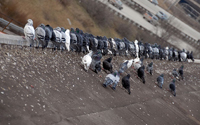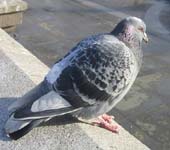| |

Call
now
to solve your Pigeon problems.
727-710-0373
Serving
Tampa Bay area, FL with feral
pigeon control 7 days a week
Click
here for free estimate
Pigeons or Rock Doves are fairly
common in the Tampa Bay area.
Go to any place people might be
eating food and dropping crumbs
and these birds will be in abundance
Pigeons
are not native wildlife and can
be a huge nuisance. Their droppings
are unattractive, damaging and
full of disease.
If
you have a nuisance pigeon problem
in your home or building give
The Trapper Guy a call. We specialize in pigeon control and removal.
Call
today to have your Pigeon problem
resolved!
727-710-0373
|
Excerpt
from article:
Pigeons
William H. Kern, Jr
.
The pigeons or rock doves (Columba livia)
found in North America are the feral
offspring of pigeons brought to this
continent by European immigrants. Pigeons
are domesticated animals raised for
sport racing, show and for food (squab).
The ancestors of the pigeons we see
in our cities and on our farms escaped
from captivity and found a favorable
environment living with humans. Feral
pigeons now have a cosmopolitan distribution,
having become established every place
humans have built cities.
Description
The feral pigeons found in Florida and
North America are extremely variable
in coloration. They exhibit the full
range of coloration that domestication
and selective breeding have produced.
All pigeons that were developed from
rock doves (Figure 1) have a white rump,
usually a white diamond-shaped patch
just above the tail feathers. In white
birds the white rump blends with the
general body color. Many pigeons have
retained the ancestral rock dove coloration:
gray body, darker gray head and neck,
white rump, dark band on the end of
the tail, dark wing tips, and two black
stripes running along the back edge
of each wing. The total length is around
11-13 inches (28-33 cm).
Range
and Habitat
The pigeon is found throughout Florida,
congregating in urban, suburban, and
rural agricultural areas. It is hard
to know the range of the ancestral rock
dove because feral pigeons are so widely
distributed, but they are believed to
naturally occur in southern Europe,
the middle east and north Africa. Rock
doves nest on protected cliffs and inside
the mouths of caves. Human cities are
made of artificial cliffs (buildings)
and caves (attics, abandoned buildings,
open warehouses) so these pigeons feel
at home and flourish.
Food
and Food Sources
Pigeons feed primarily on seeds and
grain, but in urban areas they also
eat human food scraps like bread crumbs,
etc. Bird feeders provide a primary
food source for pigeons in urban and
suburban areas. Pigeons are especially
fond of cracked corn and sorghum or
milo seeds in general bird seed mixes.
In agricultural areas pigeons eat or
contaminate large amounts of livestock
feed. Pigeons are not picky about their
food: they are often seen picking undigested
seeds from the feces of livestock.
Reproduction
Pigeons breed year round in Florida.
The nests are simple platforms of sticks
built in sheltered locations on horizontal
ledges. Pigeons commonly nest on man-made
structures; window ledges, balconies,
under bridges, in barns and open warehouses,
on or behind signs, and in soffits and
attics of houses. They enter attics
through missing soffit panels or attic
vents. A clutch normally consists of
1 or 2 eggs. The incubation period is
16-18 days and fledglings leave the
nest at 4-6 weeks of age. Adult pigeons
feed their babies a material secreted
by their crops called "Pigeon's
milk".
Problems and
Solutions
Aesthetic and Economic Problems
Pigeon droppings deface many urban buildings,
monuments, and public spaces. The uric
acid (white material) in their droppings
is not just unsightly; it can damage
the finish on buildings, automobiles,
etc.. When birds occupy warehouses and
defecate on stored goods, this creates
an expensive problem for the warehouse
management when their customers (retailers)
refuse to accept contaminated goods.
Health-Related
Problems
The most common problem associated with
feral pigeons nesting in buildings is
bird mites invading the human occupied
space during or after the nesting season.
Bird mites, like northern fowl mite
and tropical fowl mite, will bite humans
and cause a small pustule, similar to
a chigger bite. Pigeons are also important
reservoirs and vectors of reintroduction
of fowl mites into previously treated
poultry houses. Pigeon nests canalso
be a source of stick-tight fleas, soft
ticks, bed bugs, and dermestid (carpet)
beetles invading buildings.
Pigeons have been long
associated with disease organisms transmissible
to humans and livestock. These include:
13 bacterial diseases including salmonellosis
( Salmonella food poisoning), fowl typhoid,
paratyphoid, pasteurellosis , streptococcosis
, and tuberculosis ; five fungal diseases
including aspergillosis, blastomycosis
and histoplasmosis ; six protozoan diseases
including toxoplasmosis and coccidiosis;
chlamydiosis ; the rickettsial disease
Q Fever; eight viral diseases including
eastern equine and St. Louis encephalitis,
Newcastle disease and fowl pox of poultry;
the tapeworms in the genus Taenia, Davainea
proglottina, and Railletina tetragona
; four genera of parasitic nematodes
of poultry including Tetramares (2 sp.),
Capillaria (5 sp.), and Acuaria spiralis
; and 14 parasitic flukes of poultry,
livestock, and humans.
Pigeons are generally
a more serious disease vector to livestock,
especially poultry and egg producers,
than to humans. Still, the presence
of pigeons where food is prepared or
people eat-such as picnic areas and
outdoor restaurants-should be a cause
for concern about the spread of Salmonella
bacteria.
Tampa pigeon info
Footnotes
1.
This document is Fact Sheet SS-WEC-117
(UW117), one of a series of the Department
of Wildlife Ecology & Conservation,
Florida Cooperative Extension Service,
Institute of Food and Agricultural Sciences,
University of Florida. Originally published
in cooperation with the Florida Fish
and Wildlife Conservation Commission's
Nongame Wildlife Program. Publication
date: October, 1996. Revised: August
200. Please visit the Edis Web site
at http://edis.ifas.ufl.edu
2.
William H. Kern, Jr., Ph. D., associate
professor, Department of Entomology
and Nematology, Ft. Lauderdale Research
and Education Center, Davie, FL 33314,
Cooperative Extension Service, Institute
of Food and Agricultural Sciences, University
of Florida, Gainesville, 32611
|
|
|

Fully
insured nuisance wildlife
trapper. Let me help
you with your pigeon control.
.
|
| 
Pigeon
The
Trapper Guy is not a pest control
company. I do not
use poisons or service bugs.
|

|
|